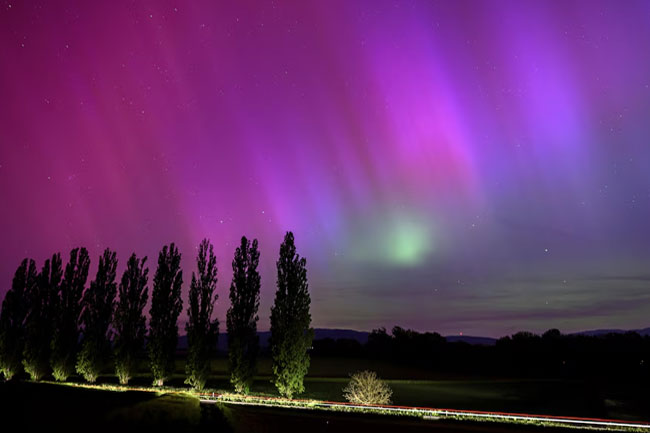In a rare event, Earth finds itself at the mercy of an unusually potent solar storm, raising concerns over potential disruptions to power grids and communication networks. The National Oceanic and Atmospheric Administration (NOAA) issued a severe geomagnetic storm warning as a solar outburst unexpectedly reached our planet, arriving hours earlier than anticipated. The repercussions are forecasted to persist through the weekend, possibly extending into the upcoming week.
Rob Steenburgh, a scientist with NOAA’s Space Weather Prediction Center, reassures that for most individuals, the impact will be minimal, requiring no immediate action. However, precautionary measures have been advised for operators of power plants and spacecraft in orbit, as well as by the Federal Emergency Management Agency (FEMA).
One of the anticipated spectacles of this solar event is the potential for northern lights, or auroras, to be visible even in regions as far south as Alabama and Northern California. Yet, experts caution that these displays might not manifest in the grandiose curtains of color commonly associated with the aurora borealis, but rather as subtle greenish hues.
“The gift from space weather is the aurora,” remarks Steenburgh, suggesting that phone cameras might capture these phenomena better than the naked eye. Mike Bettwy, operations chief for the prediction center, encourages sky enthusiasts to snap pictures, as there might be delightful surprises awaiting them.
While this solar storm is not anticipated to rival the intensity of the 1859 event, which saw auroras as far south as Central America, its potential impact on Earth’s infrastructure is not to be underestimated. High-voltage transmission lines for power grids and satellites, crucial for navigation and communication services, are at risk.
Shawn Dahl, a NOAA space weather forecaster, highlights the vulnerability of power grids and satellites, citing the extreme geomagnetic storm of 2003, which caused power outages in Sweden and damaged transformers in South Africa.
Even after the storm subsides, the aftermath could disrupt signals between GPS satellites and ground receivers. However, the abundance of navigation satellites should mitigate any prolonged disruptions, assures Steenburgh.
This solar upheaval stems from a series of strong solar flares observed since Wednesday, accompanied by multiple coronal mass ejections (CMEs), each containing vast amounts of plasma and magnetic fields from the sun’s corona. These eruptions are associated with a colossal sunspot, indicative of the sun nearing the peak of its 11-year cycle of solar activity.
NASA has stated that the solar storm poses no immediate threat to the astronauts aboard the International Space Station (ISS), with concerns primarily centered around heightened radiation levels. Precautionary measures, such as relocating to better-shielded areas of the station if necessary, have been outlined by Steenburgh.
Antti Pulkkinen, director of NASA’s heliophysics science division, acknowledges the potential risks posed to sensitive scientific instruments aboard satellites, with plans to deactivate them if needed to prevent damage.
Amidst the chaos, numerous sun-focused spacecraft diligently observe and monitor these celestial events, providing invaluable insights into our sun’s behavior.
“This is exactly the kind of thing we want to observe,” affirms Pulkkinen, underscoring the significance of studying such phenomena to enhance our understanding of space weather and its impact on Earth.
As we navigate through this solar storm, vigilance and preparedness remain paramount, ensuring the resilience of our technological infrastructure in the face of nature’s cosmic fury.


